Just because you kick some soil around in the spring and guess that you have enough soil moisture, you really have no idea what’s actually going on until you dig down and take a look (which takes time) or use IoT technology (easier approach) to know what you have. Here comes Yield Prediction.
Yield Prediction – Dig that?
In the second installment of Farm Weather Talk, we discussed the benefits of site-specific weather forecasts and why they are a must for integration into all farm-field decision support tools since they are a part of the solution to reduce the “Uncontrollable Risk” that farmers face on a day-by-day basis. In this installment, we are going to dig into how a weather station or IoT device with a forecast can be used to make yield prediction to the current date but also to maturity.
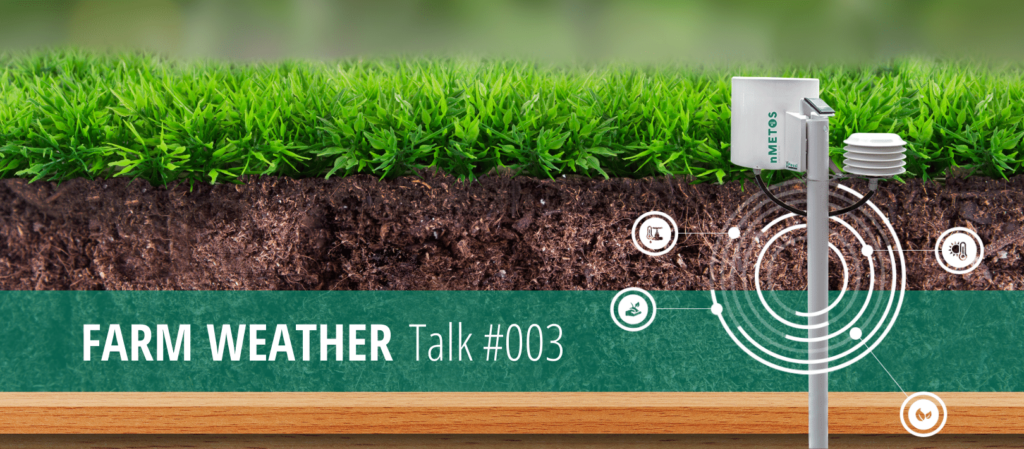
Just because you kick some soil around in the spring and guess that you have enough soil moisture, you really have no idea what’s actually going on until you dig down and take a look (which takes time) or use IoT technology (easier approach) to know what you have. Soil type-specific data can be collected and translated into exactly where you are at in terms of soil moisture in a water-driven crop yield and provide a very good answer to a particular problem, such as nutrition. If you know you only have five inches of stored water versus nine inches of stored water in a different soil profile, you are going to manage nutrients and the crop differently.
Yield Prediction Backgrounds
The yield of any crop is based on the genetic potential of the seed, the amount of soil moisture at seeding, growing season precipitation (and irrigation), proper fertility rates and other timely management decisions: weed control, disease management, insect control and of course weather factors which is usually the most significant uncontrollable risk.
In simplistic terms, a plant or crop development is very similar to a checkbook (inputs and outputs), where you have supplied (precipitation and/or irrigation) and demand (temperature) side. Therefore, the two most important factors for yield are moisture supply and temperature, given that all other field management decisions are carried out properly.
Temperature or heat is important since it determines the water use and whether a crop will mature or suffer heat stress, but the moisture supply has the most significant impact on yield potential since its responsible for carrying nutrients to the plant for photosynthesis. This is why moisture supply is often referred to as the CROPS GAS TANK for yield potential.
Each crop has water use efficiency curves related to yield. Research and field trials over years have identified the number of bushels produced from each inch or 25mm of soil water used by a crop. For some common crops this equates to 5-6 bu in canola, 7-8 bu for wheat and 10 to 12 bu of corn yield increase for each additional inch or 25mm of soil water added. The number of bushels produced per inch or 25 mm of soil water will change over time as new varieties are released with better genetics.
Therefore, the total amount of soil water available (supply) to a crop during the growing season is equal to the amount of soil moisture available at seeding time (determined by soil type) plus the amount of precipitation and/or irrigation (soil moisture) received over the growing season. The use or demand of soil water is determined by temperature and soil type/texture. These two factors (supply and demand) define the yield potential.
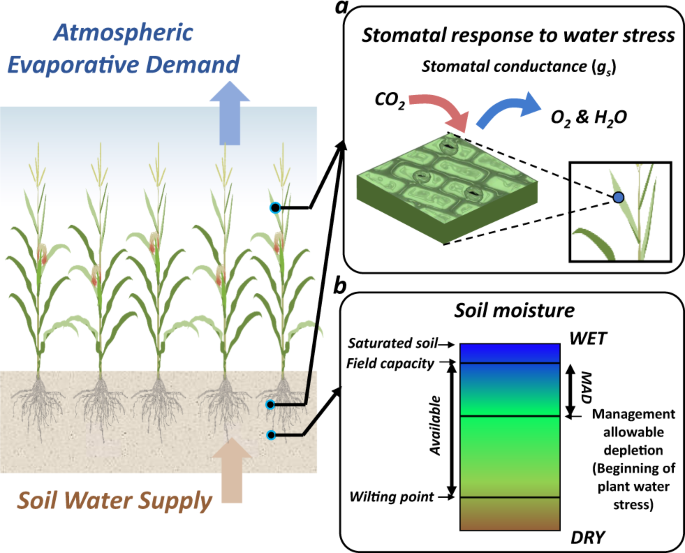
As mentioned, soil type/texture is a critical factor in determining how much soil water plants have available for development. In fact, plants can’t use all the water held in the soil. The upper limit is Field Capacity, while the lower limit is Permanent Wilting Point.
Field Capacity is the maximum amount of water held in the soil, measured a couple of days after a saturation event (heavy rainfall or irrigation event).
Permanent Wilting Point occurs if a plant can longer withdraw water from the soil to meet its needs, then it will begin to wilt, that is the point at which water is no longer available to the plant.
Plant Available Water is the difference between field capacity and the wilting point where the plant can no longer extract water from the soil. In other words, not all water held in soil is available to plants.
This is why an Allowable Depletion level is used based on soil type and crop. In most cereal and oilseed crops, the allowable depletion levels are 50% of field capacity, while for vegetables and root crops, this level is at 65% of field capacity.
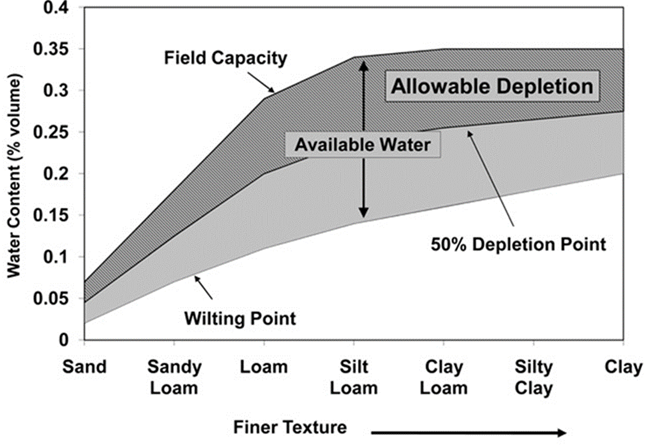
The illustration clearly shows that sand or sandy loam soil has limited soil water available for crop development, while a silt loam or clay loam has a much larger gas tank of soil water, and hence higher yield potential typically. In other words, the sandy loam soil needs to be recharged more often than clay loam soil. The table below illustrates that coarse soil can store 5.7 inches (145 mm) of water to 4 feet or 120 cm, while fine soil can store 10.4 inches (265 mm) of water in the same depth of profile.
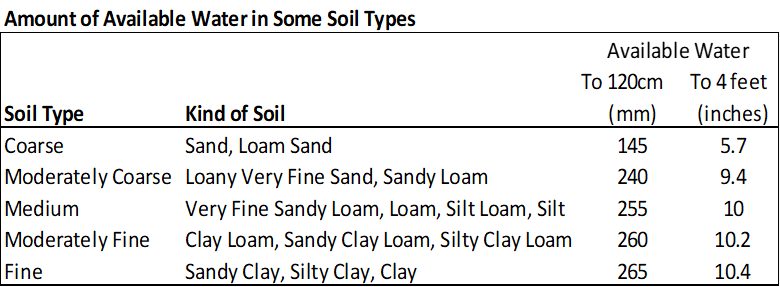
Ok, we’ve talked about the factors that drive yield in a crop, but how do we make an estimate of yield to the current date and then to maturity for a field? This is where the field IoT device and forecast come in. Let’s explore how this is done.
Yield Prediction Setup
First, you need to spatially define the field location or Cropzone(s) that you want to make the yield estimate for. The illustration below shows how this is done, by defining the cropzone within a field. Cropzones are usually defined based on soil type and topography.
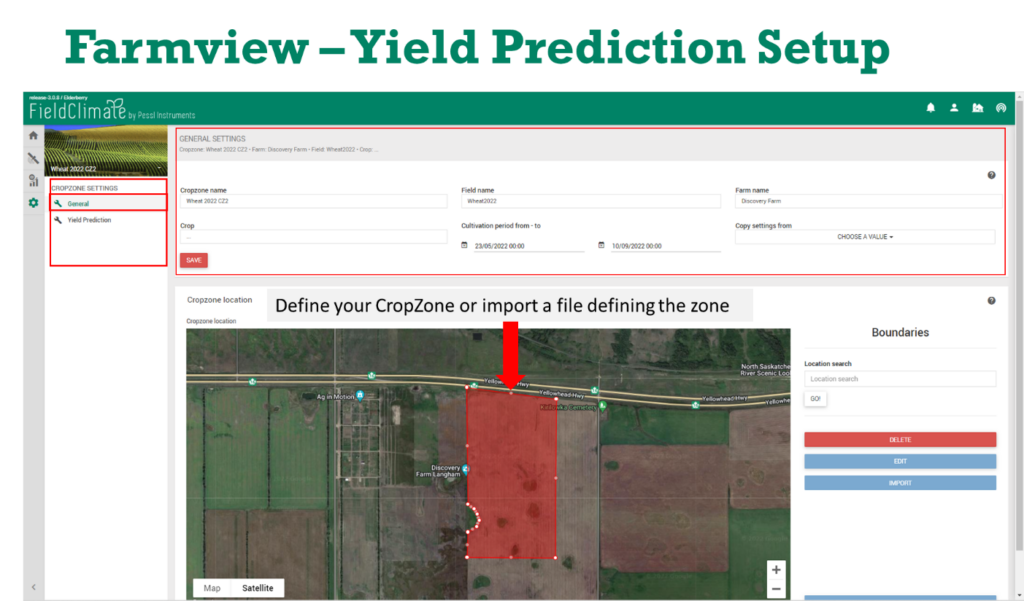
Since we are using a model to predict water use by the crop, we need to set several parameters: crop type, seeding and expected harvest date, best possible average yield, initial soil moisture, soil type, field capacity and wilting point, air temperature station and rain source as shown in the illustration below.
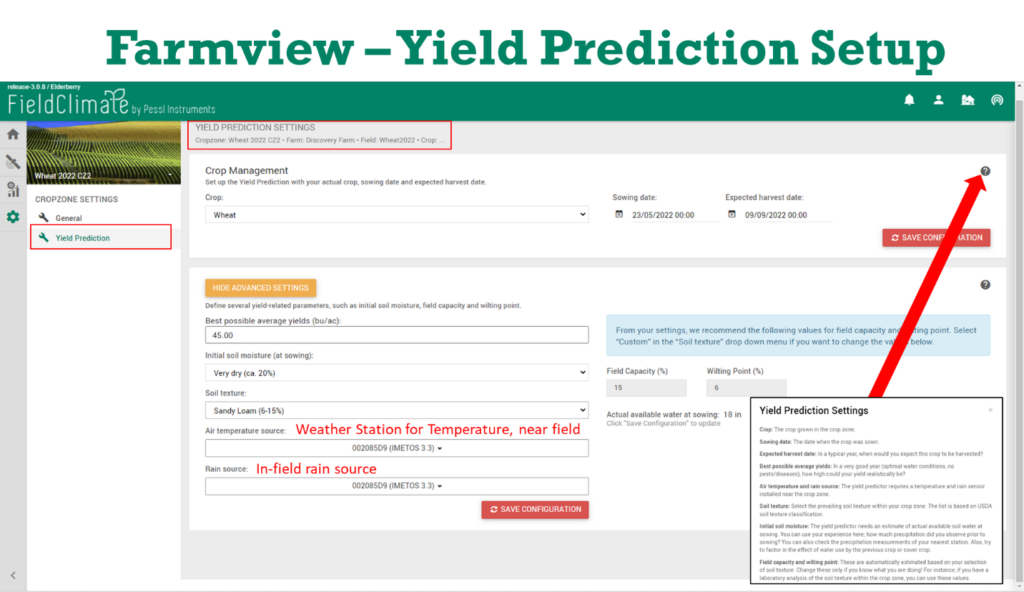
For the selection of IoT devices, the temperature is used to estimate crop development, while the precipitation gauge is used to capture the amount of water added to the soil. So, the station with the precipitation gauge should be in or at the edge of the field to make sure that the values are representative of that field.
The temperature device can be on the same station or from a station that is nearby, since temperature does not change much over a short spatial distance like precipitation. The illustrations below show two types of stations that can be used µMETOS or nMETOS for this type of application.

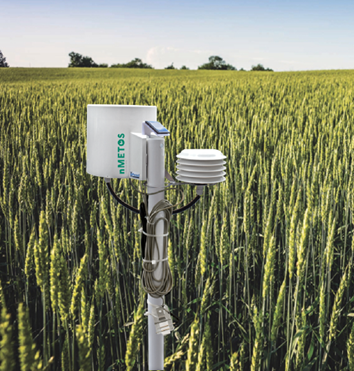
The initial soil moisture is important since it sets how much soil water is available at the time of seeding based on the soil type (how much water is in the gas tank at the start of the year). Changing these two values will create different yield scenarios (planning tools) for the cropzone.
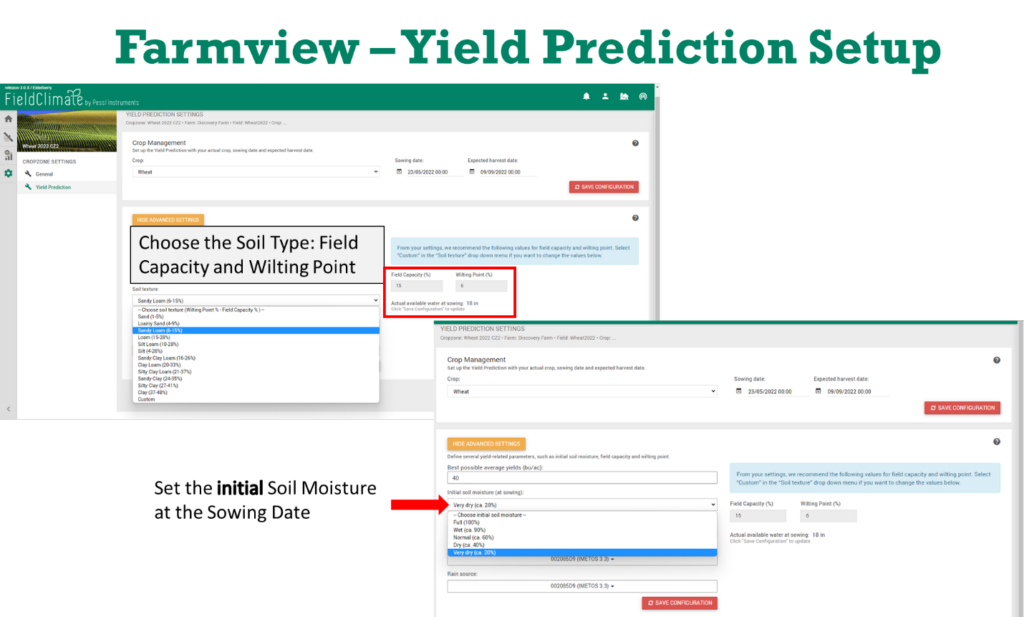
Yield Prediction Results
Ok, we discussed the importance of having an IoT device with a forecast to help reduce the uncontrollable risk farmers face, but how does this work for yield prediction?
For the yield prediction solution, we use Long Term Normal forecast (average normal rainfall) to the current date and to physiological maturity. We also use a Seasonal Adjust forecast which uses the observed conditions (precipitation) to date plus a seasonal adjusted forecast based on the type of season (wet, normal, or dry). These terms and illustrations are described below.
Terms Used on the Yield Prediction Graph:
- Yield “to date” (current season): This prediction includes your station-measured precipitation since sowing and your setting of initial soil moisture. It assumes no further rainfall after today for the rest of the season, i.e., a worst-case scenario.
- Predicted crop physiological maturity: The prediction of the finalization of yield formation (i.e., no further increase in yield after this date). Note that harvest is usually some weeks later, depending on the crop, as grains need to dry down.
- Predicted yield at harvest (long-term normal season): This assumes average rain (normal season) for the entire season, starting with your settings of initial soil moisture.
- Predicted yield at harvest (current season + rain forecast): This value considers not only your initial soil moisture setting and station-measured rainfall since sowing but also a seasonal forecast until the predicted crop physiological maturity date. However, keep in mind that seasonal rain forecasts come with considerable uncertainty. Note that when today passes crop physiological maturity date, this value will be identical to Yield “today” (see above), since at this time, the prediction is based entirely on station-measured data.
Please note: The predicted yield values represent an estimate of potential yield at harvest. This estimate is largely based on estimates (measured, historic average, and forecast) of precipitation. Other yield-limiting factors such as pests, diseases, soil fertility, and others are (currently) not considered. There is no guarantee that your actual yield at harvest will be within the presented ranges. However, the predicted values can serve as an in-season indication of whether the crop’s yield performance is likely to fall below or beat the historic average. Use this additional information when making management decisions such as fertilization or irrigation.
The illustration below shows the predicted seasonal adjusted forecast and the long-term normal forecast. Clearly, the season is much drier than normal resulting in poor yields. The management decision might be to hold off on any other nutrients due to the lack of soil water for yield. Based on this decision, other management practices would probably be adjusted as well.
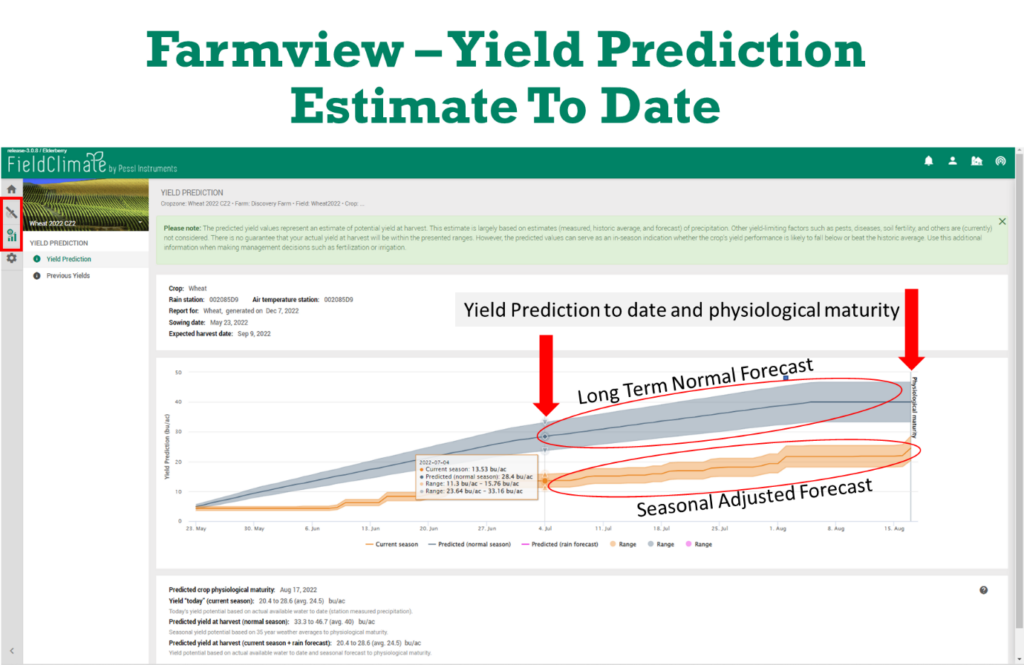
In combination with yield prediction, satellite imagery is offered for the specific field or cropzone. We offer two satellite indices from the Sentinel 2 satellite (10-meter resolution): LAI (leaf area index) and NDVI (normalized difference vegetation index). Each can be used to either look at the amount of ground cover or the ground cover and vegetation vigour. The higher the number or brighter the green in the legend means a more vigorous crop.
The image below illustrates the green-up of the crop over the growing season with the differences in plant health across the field. Higher green areas represent healthier crops, while beige values represent less plant vigour. The imagery clearer shows the in-field variability or abnormal development which can be further investigated for other management concerns: water, fertility, disease, or insect issues. The peak NDVI value or peak of the curve has been associated with over-yield potential and peak biomass development. This is also clearly seen in the image below.
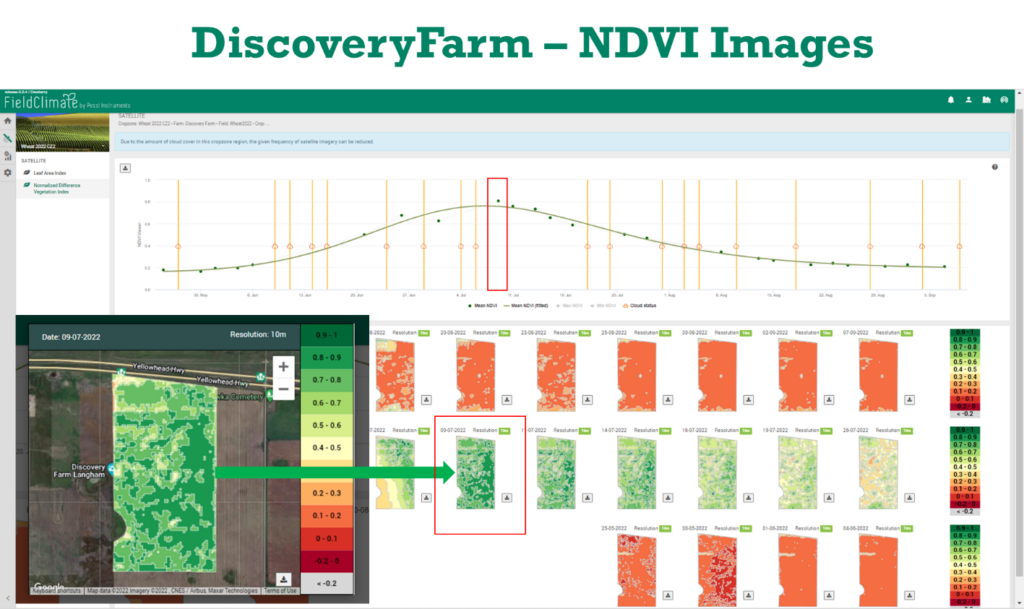
If you have combined harvester data, you can also compare the results with the satellite imagery as the illustration shows below. Higher NDVI areas are associated with higher combined yields.
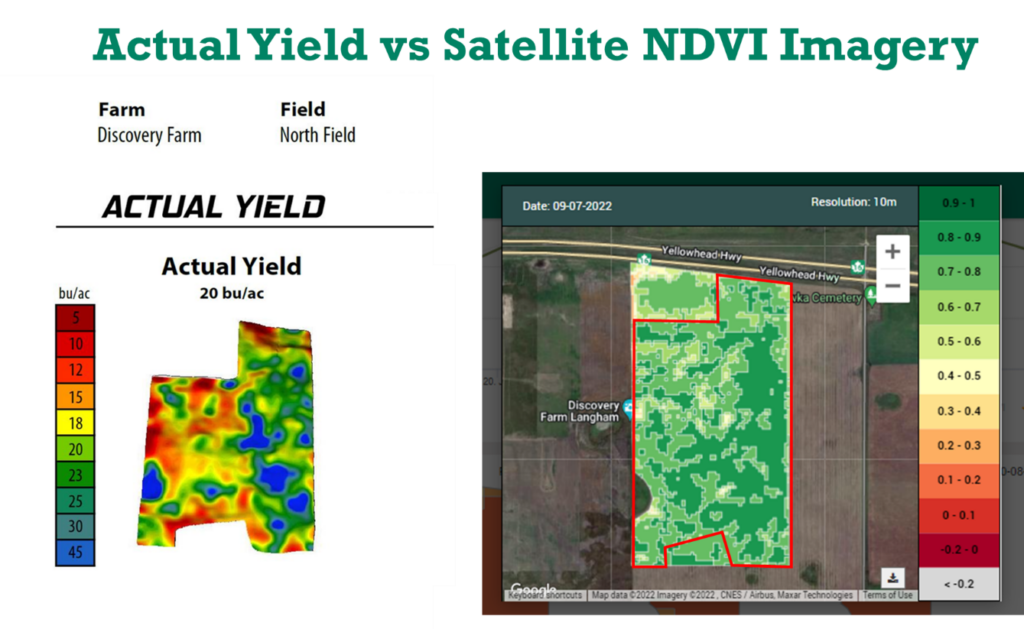
What have we learned and what were the results?
Based on predictive cropzone yield and satellite information, a farmer can adjust important management decisions during the growing season regarding water, disease, insect management and additional fertilizer application. Improve nutrient management: the right rate and time for higher yields and quality of crops. For the demonstration field used in this talk, the Yield Prediction Solution estimated an average yield of 22 bu/acre, which is very poor because of a dry year, while the average combined yields were 20 bu/acre. So, as discussed before, an IoT field device should go hand-in-hand with a field-level forecast for enhanced management decisions to help reduce the uncontrollable risk a farmer faces in day-to-day operations.
About the Author:
Guy Ash has worked as agro-meteorologist and earth observations science specialist for the past 30 years. Currently, he is the Global Training and Key Accounts Manager in Canada for Pessl Instruments, Austria. Pessl Instrument is an IoT company that manufactures hardware (loggers and sensors) and software solutions that are focused on the agricultural sector. We work in over 85 countries and have over 70,000 devices and 700,000 sensors deployed for a wide range of agriculture applications: disease management, irrigation, soil moisture, insect traps, crop cameras, weather stations, soil fertility, etc. One of his roles is to provide global training for an extensive list of IoT solutions for a wide variety of crops – rice, wheat, soybeans, oranges, corn, canola, forages, grapes, fruits and vegetables, etc.
![]()
